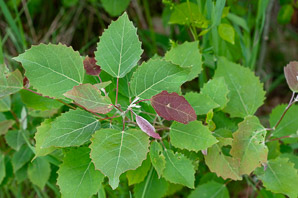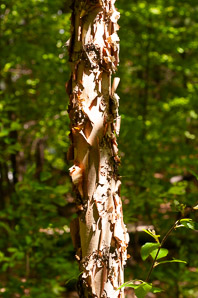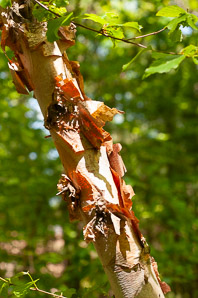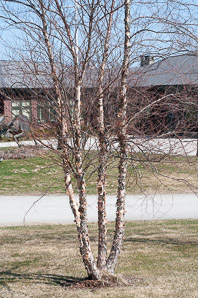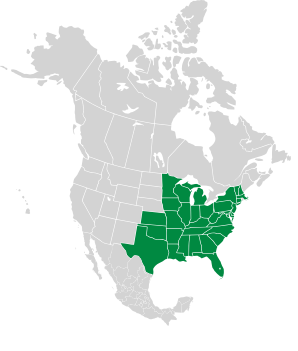
|
Betula nigra L. River birch, black birch
River birch is native to the eastern United States. Identification: Trees are up to 82′ (25 m), rarely reaching 98′ (30 m). They often have multiple trunks. The bark is highly variable. As with other birches, it peels away spontaneously ("exfoliates"), making the trunk look ragged. It may be dark gray-brown and scaly, pinkish-brown, or white and papery. Trees tend to be pyramid-shaped when they are young, becoming more irregular as they age. Leaves are dark green, alternate, unlobed. They are roughly diamond-shaped, with the top half of the diamond more pointed and with doubly serrated edges, while the bottom half is flatter and with smooth edges. Leaves turn yellow in the fall. Male and female flowers appear on the same tree. Male catkins are up to 3″ (7.6 cm) long in April, while the female flowers are inconspicuous. Online References:
The Ohio State University PLANTFacts database The USDA Forest Service's Silvics of North America site References:
Sibley, David Allen, The Sibley Guide to Trees, Alfred A. Knopf, 2009, p. 158 Petrides, George A., Peterson Field Guides: Trees and Shrubs, Houghton Mifflin Co., 1972, p. 234, 338 Dirr, Michael A., Dirr’s Hardy Trees and Shrubs, Timber Press, 1997, p. 56 Symonds, George W. D.; photos by Chelminski, Stephen V., The Tree Identification Book, Harper, 2003, p. 44 5/29/2010 · Maine Audubon Gilsland Farm Audubon Center, Falmouth, Maine · ≈ 12 × 8″ (31 × 20 cm)
Betula nigra description by Thomas H. Kent, last updated 25 May 2020. © FloraFinder.org. All rights reserved. |
5/15/2010 · Garden in the Woods, Framingham, Massachusetts · ≈ 1 × 1½′ (34 × 52 cm) 5/15/2010 · Garden in the Woods, Framingham, Massachusetts · ≈ 10 × 15″ (26 × 39 cm) 4/3/2010 · Point Lookout (Elev 550'), Lincolnville, Maine Range: Zones 4-9:
|
